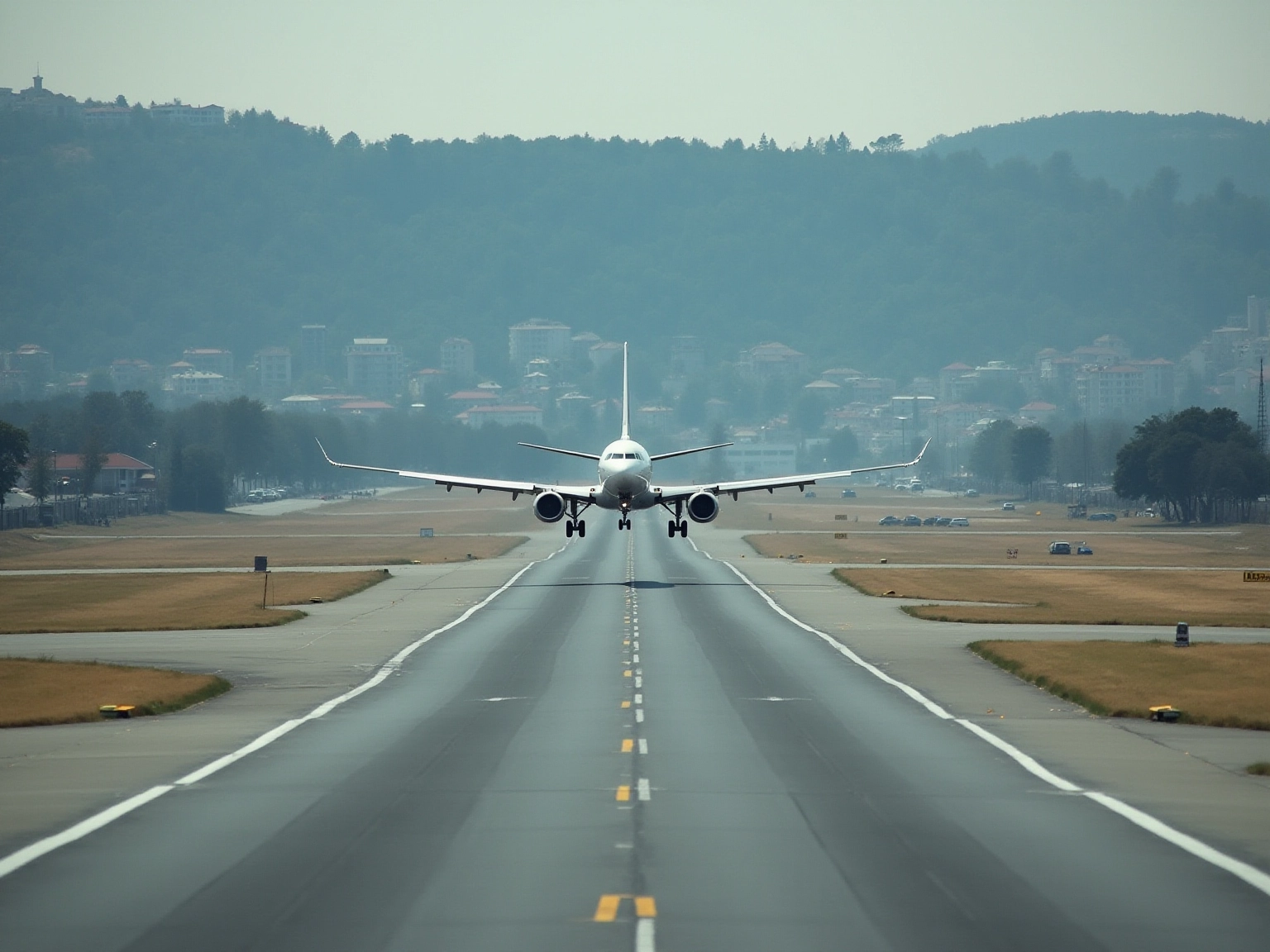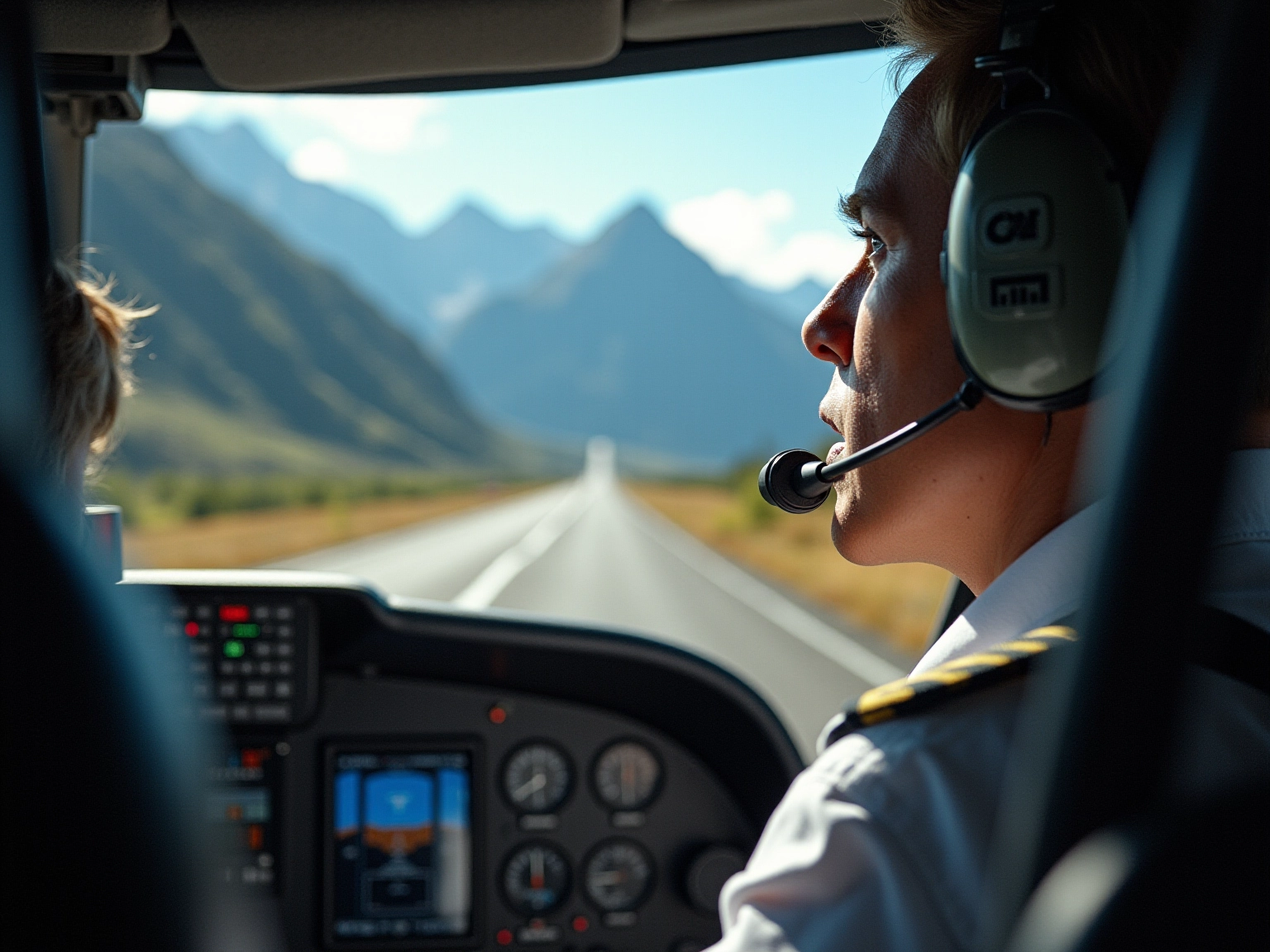Overview
Have you ever wondered what makes some airports the most dangerous in the world? Well, they’re often marked by short and poorly maintained runways, tricky terrain, and unpredictable weather conditions. These factors can really ramp up the risks during takeoff and landing!
Take Lukla and Courchevel, for example. These airports are perfect illustrations of the challenges pilots face in high-risk environments. It’s crucial for pilots to undergo advanced training and adhere to strict safety protocols when navigating these tricky spots.
So, if you’re planning to travel to these adventurous destinations, remember that safety is key! With the right preparation and knowledge, you can embark on your journey with confidence!
Key Highlights:
- Aviation risk evaluation involves factors such as runway length, terrain, weather conditions, and accident frequency.
- Short and poorly maintained runways increase risks during takeoff and landing.
- Advanced technologies, like machine learning models, can predict risks by analyzing historical flight data.
- Airports like Lukla and Courchevel present unique challenges due to their short runways and difficult approaches.
- Pilot training for hazardous landings includes simulator sessions and emphasizes situational awareness and adaptability.
- Weather conditions significantly contribute to aviation incidents, especially during transitions from VFR to IMC.
- Geographical influences, such as mountainous terrain and coastal weather, affect flight safety and crash rates.
- Strict safety protocols and comprehensive training programs are essential for pilots navigating high-risk airfields.
- Passenger anxiety about flying into dangerous airports can be mitigated through clear communication and support from airlines.
- Future advancements in aviation safety are expected to stem from improved technology and training protocols.
Introduction
In the world of aviation, the phrase “dangerous airport” sparks a blend of excitement and a bit of nervousness, doesn’t it? You might find yourself wondering about the unique challenges these places present. Take, for instance, the tricky short runways of Lukla Airport in Nepal or the steep gradients of Courchevel Altiport in France—each one has its own tale of risk and skill! By understanding what makes these airports so perilous—like geographical factors, weather conditions, and advanced safety protocols—you gain valuable insights that can benefit both pilots and passengers alike.
As the aviation industry keeps pushing the envelope of innovation, the focus on enhancing safety measures is more crucial than ever. This ensures that air travel remains both thrilling and secure for everyone involved. So, let’s dive into the fascinating complexities of the world’s most perilous airports together! We’ll explore the risks they pose and the clever strategies in place to navigate them. Are you ready for this adventure?
Defining Airport Danger: Key Factors and Criteria
Evaluating aviation risk is all about a multifaceted approach that takes several critical factors into account—like runway length, surrounding terrain, weather conditions, and accident frequency. You see, short or poorly maintained runways can really ramp up the risks during takeoff and landing, making them a top concern for aviation security. For example, transportation hubs nestled in hilly areas or those prone to unpredictable weather face unique challenges that can complicate flight operations, such as turbulence and limited visibility.
Research shows that runway length plays a pivotal role in shaping a facility’s security profile. Airports with shorter runways often demand more precise piloting, which can lead to higher incident rates during those crucial phases of flight. Plus, the landscape around an airfield can affect approach and departure routes, with obstacles like mountains or urban structures adding to the risks.
Now, let’s talk about how advanced technologies can step in to enhance aviation security. A recent study titled “Enhancing Airport Safety with Machine Learning” showcased the power of an LSTM-based model, utilizing 128 hidden units, to predict risks tied to flight operations by analyzing historical data—like weather conditions and facility readiness. This model achieved impressive prediction accuracy, highlighting the potential of data-driven approaches to boost safety assessments.
As Feng Gu from the Civil Aviation Flight University of China pointed out, effective data curation is key for accurate risk assessment in aviation.
Understanding these standards is vital for both aviators and travelers, as they reveal the inherent dangers associated with some of the world’s most challenging airports. By recognizing the complexities involved in air travel operations, you can make more informed decisions and gain a deeper appreciation for the challenges faced by aviation professionals in ensuring safe flights. This knowledge not only enriches your travel experience but also aligns perfectly with The Design Tourist’s commitment to storytelling and practical advice, empowering you to connect more deeply with the places you visit.

A Closer Look at the World’s Most Dangerous Airports
Lukla in Nepal is often regarded as one of the most dangerous airports in the world! Its notoriously short runway and tricky approach leave aviators with very little room for error. This airfield, frequently dubbed the gateway to Mount Everest, is infamous for its unpredictable weather and high-altitude operations, which truly test an aviator’s skills.
Similarly, Courchevel Altiport in France, nestled in the French Alps, demands exceptional precision from pilots due to its steep gradient and limited landing space. This makes the landing process quite a challenge!
Other notable airfields include:
- Toncontin International in Honduras, which is well-known for its daunting approach through mountainous terrain. Here, pilots must navigate sharp turns and sudden altitude changes—definitely not for the faint of heart!
- Princess Juliana International Airport in St. Maarten, recognized for its low-altitude landings that glide over a public beach, creating a breathtaking yet risky experience for both pilots and beachgoers.
- Daocheng Yading in China, the highest civilian airfield on the planet, presents its own unique challenges. Situated nearly 15,000 feet above sea level, it was constructed to enhance access to the Yading Nature Reserve and significantly cut travel time from two days by bus to just one hour by flight. This transit hub not only boosts tourism but also challenges pilots with its high-altitude operations and unpredictable weather.
- Telluride Regional Airport in the USA, known for its high elevation, features sheer cliffs and strong turbulence, making landings quite complicated.
These air travel hubs really put even the most experienced pilots to the test, highlighting the inherent dangers of flying in what many consider the most perilous airports in the world. As Jim Dobson, a senior contributor, puts it, “I have arrived at this location many times, and it is definitely a white-knuckle experience.”
For instance, the tragic crash of a TAM airlines A320 at Congonhas Airport in São Paulo, Brazil, in 2007, which resulted in the loss of all 187 passengers and 12 individuals on the ground, underscores the potential dangers that can arise in high-stakes landing scenarios.
As we delve into the intricacies of these aviation hubs, it becomes clear that each one presents distinct challenges that test the resolve of pilots, making them some of the most dangerous airports in the world to land. Are you ready to explore these thrilling destinations?
Pilot Challenges: Navigating Dangerous Landings
Landing at the world’s most dangerous airport is no small feat! Aviators need exceptional skills and rigorous training to tackle the unique challenges these locations throw at them. Take Lukla Airport, for example. It’s famous for its perilous conditions, where pilots must make a steep descent onto a runway that’s just 527 meters long and flanked by towering peaks. With such limited space, there’s hardly any room for error—precision and skill are absolutely crucial!
Then there’s Courchevel Airport, where pilots face rapidly changing weather conditions and must master short-field landings. This kind of landing demands a high level of expertise and quick decision-making, making it an exhilarating challenge.
To gear up for these tough situations, aviators dive into comprehensive training, including simulator sessions that replicate the specific conditions they’ll encounter at these airports. This training is vital! It equips them with the skills needed to navigate the complexities of their approach and landing. Did you know that weather-related accidents, especially those involving Visual Flight Rules (VFR) transitioning into Instrument Meteorological Conditions (IMC), account for over 60% of aviation incidents? That really highlights the importance of weather awareness and readiness, no matter how experienced a pilot may be.
But it’s not just about technical skills! Aviation trainers stress the importance of strong situational awareness and adaptability when landing at risky airports. Real-world examples of steep descent landings at Lukla showcase just how essential these skills are. Aviators must stay calm and focused under pressure. As Timothy L. Arel, Chief Operating Officer of the Air Traffic Organization, puts it, “The FAA will doggedly press for continued collaboration with industry to further enhance security initiatives and technologies to reduce runway incursions with the goal of eliminating them.”
This commitment to security is so important, especially with the number of commercial pilots expected to rise from 56,500 in 2023 to 59,700 by 2033. This growth elevates the need for thorough training programs that tackle the challenges of hazardous runway landings, particularly at the world’s most dangerous airports. Additionally, the FAA plans to recruit and train 1,800 air traffic controllers in FY 2024 to meet current traffic demands and bolster security in the National Airspace System. It’s clear that comprehensive training and protocols in aviation are more crucial than ever!

Geographical Influences: How Terrain and Weather Affect Safety
Geographical elements play a huge role in aviation safety, especially in regions with challenging landscapes. Take Paro Airport in Bhutan, for example—it’s nestled in the mountains and faces some unique hurdles. You might encounter turbulence from the surrounding peaks and limited visibility due to unpredictable weather. Did you know that turbulence statistics show that hilly areas often experience more severe turbulence? This can pose serious risks during takeoff and landing!
Now, let’s not forget about coastal airports! They have their own set of challenges, like sudden weather shifts—think dense fog and strong winds—that can make landing tricky. Meteorologists have noted how these conditions can lead to sudden drops in visibility, so it’s crucial for pilots to be prepared for whatever Mother Nature throws their way.
Understanding these geographical influences is key for both pilots and passengers. It highlights the inherent risks of flying into some of the world’s more dangerous airports. Studies have shown a clear connection between geographic location and crash rates, particularly at the most perilous airports. For context, the overall crash rate in the United States is 8.9 crashes per 100,000 flight hours, with the Alaska and Northwest Mountain regions showing the highest rates of crashes and fatalities.
This really underscores the need to tackle the unique challenges posed by these risky airports.
A fascinating case study titled “Geographic Variations in Crash Risk of General Aviation and Air Taxis” dives into crash data and emphasizes the importance of enhancing aviation safety in mountainous regions. Real-world examples of turbulence at these airports illustrate just how critical these geographical factors can be. The interplay between terrain and weather not only affects flight safety but also shapes the operational protocols pilots must follow.
As Kenneth Wong points out, having guidelines for quality development in commercial human space flight regulations is essential. This highlights the importance of regulatory measures in aviation, especially in challenging geographical areas.
As the aviation industry continues to evolve, grasping the impact of geography on airport safety is vital for ensuring safer travel experiences. Plus, there’s a pressing need for thorough spatio-temporal analysis of aviation hierarchies to fully understand their role in the global economy and how disruptions affect the air transportation system.
Safety Protocols: Training and Measures for Risk Mitigation
When it comes to the inherent dangers of hazardous airfields, airlines are serious about safety. They roll out strict security measures and comprehensive preparation programs for aviators. These initiatives include specialized training tailored for techniques and landings at specific high-risk airfields. Plus, routine simulations of emergency situations help equip aviators for any unforeseen challenges that might come their way. And let’s not forget, airlines conduct thorough risk evaluations of the terminals they operate in, giving aviators the essential info they need about the unique challenges they might face during flight operations.
Now, here’s something to think about: data shows that the global fatality risk in aviation jumped from 0.06 in 2023 to 0.14 in 2024. This really highlights the importance of those safety protocols! In response, aviation training initiatives have been ramped up to focus on high-risk landings. Research suggests that effective education can significantly lower incident rates. For instance, a case study on using the Long Short-Term Memory (LSTM) algorithm in aviation security risk assessment revealed a high accuracy rate, with a standard error of less than 0.18.
This model not only improved real-time monitoring capabilities but also provided early alerts, boosting aviation safety overall.
Experts from the airline safety sector emphasize the crucial role of crew training in minimizing risks. They note that thorough preparation and ongoing education are vital for aviators navigating challenging environments. Real-world examples of effective flight preparation initiatives showcase how these strategies lead to safer landings and improved operational outcomes at some of the world’s most dangerous airports.
Moreover, research specialist Martin Placek points out that 71 percent of travelers consider cabin cleanliness a key factor in their airline choice after COVID-19. This underscores how important overall perceptions of well-being are! By prioritizing security protocols and investing in pilot training, airlines strive to maintain high standards and ensure their crews are well-prepared to handle the complexities of flying into high-risk areas. And just to give you an idea of the financial side, the unit cost per operation for the FAA was reported at $85.06 for FY 2016, reflecting the financial implications of these safety investments.
Passenger Perspectives: Understanding Fear and Safety in Air Travel
As you approach those nerve-wracking air travel hubs, it’s completely normal to feel a wave of anxiety wash over you. After all, places like Lukla Airport, often dubbed the ‘most dangerous airport in the world,’ certainly have a reputation that can stir up some trepidation! You’re not alone in this feeling; estimates suggest that between 15% and 40% of adults in the United States grapple with a fear of flying. This statistic really highlights just how much the idea of traveling to such a risky airport can affect your mindset.
Understanding these fears is crucial for airlines and pilots alike. When they address passenger concerns, it can truly enhance the travel experience. Experts emphasize the importance of clear communication about operational protocols and pilot training. For instance, former aviator and aviation consultant Kit Darby points out that seeing color video footage of in-flight issues can make everything feel more real, which might ramp up anxiety even more.
This brings us to the essential role of airlines in reassuring nervous travelers. If you’re worried about flying into Lukla, it can really help to know about the extensive training pilots undergo and the safety measures in place. Plus, there are practical strategies you can use to manage anxiety during your flight. A case study titled ‘Tips and Advice on How to Deal with Fear of Flying’ suggests letting flight attendants know about your anxiety. They can offer personalized support, and finding distractions—like diving into entertainment options or practicing mindfulness techniques—can work wonders!
Real-life experiences from fellow travelers can also shed light on coping with the stress of flying into challenging locations. Many find comfort in understanding the operational procedures that keep them safe, which can significantly ease their worries. By fostering a sense of security and providing support, airlines have the power to transform the daunting experience of flying into risky areas into a more manageable adventure.
This approach aligns beautifully with The Design Tourist’s mission to blend expert storytelling with practical travel advice, ultimately enhancing your travel experiences!
Of course, if something does go wrong, and you are injured as result, the personal injury lawyers at Garces, Grabler & LeBrocq, P.C. will always be on hand to help.
The Future of Aviation Safety: Innovations and Improvements
The future of aviation safety is on the brink of some truly remarkable advancements, mainly driven by exciting innovations in technology and enhanced training protocols. Imagine sophisticated navigation systems and real-time weather monitoring coming together to significantly reduce the risks of flying into the world’s most dangerous airports! Plus, the incorporation of artificial intelligence into flight operations is transforming how aviators access essential information, empowering them to make informed choices during those tricky landings.
For instance, enhanced pilot education programs have been shown to improve decision-making abilities under pressure, creating a safer flying environment for everyone. Research suggests that a staggering 32% of aviation incidents globally could have been avoided with better regulatory supervision and education. This statistic really underscores the importance of ongoing advancements in educational methodologies and regulatory frameworks.
And there’s more! A fascinating case study titled ‘Global Disparities in Air Travel Security’ reveals that countries in the lower tier of air security records experienced 36.5 times more fatalities per passenger boarding compared to those in the top tier. This highlights some significant disparities in air travel security across the globe. As these technologies and training approaches continue to evolve, they promise to reshape the security landscape of aviation, ultimately making air travel safer for passengers and crew alike.
Looking ahead to 2025, experts are optimistic that implementing advanced protective innovations will not only reduce accident rates but also foster a culture of security within the aviation sector. As Arnold Barnett, an MIT professor, puts it, “After decades of sharp improvements, it’s really hard to keep improving at the same rate. And yet they do.”
This proactive strategy for protection, combined with ongoing technological advancements, equips the aviation industry to effectively address the challenges posed by dangerous airports around the world. Moreover, the IATA’s revision of the Risk-Based IOSA maturity standards in 2024 showcases the industry’s commitment to enhancing security protocols. Leading investment priorities for airports in 2024 will also emphasize these advancements, ensuring that safety remains a top priority in aviation development.
Conclusion
Understanding the intricacies of dangerous airports unveils a fascinating interplay of factors that shape aviation risk. Key elements like runway length, geographical terrain, and unpredictable weather conditions significantly influence the safety landscape of these challenging locations. Just think about the notorious short landing strips of Lukla Airport in Nepal or the steep gradients of Courchevel Altiport in France—each airport presents unique challenges that demand exceptional piloting skills and rigorous training.
The aviation industry’s commitment to safety is truly paramount! Advanced technologies and comprehensive training programs are designed to mitigate risks. Innovative approaches, such as machine learning algorithms that enhance safety assessments, demonstrate how the industry is continuously evolving to tackle the challenges posed by dangerous airports. This proactive strategy not only safeguards pilots and passengers but also nurtures a culture of safety that is essential for the future of air travel.
Moreover, understanding passenger perspectives and addressing their fears is crucial for ensuring a positive travel experience. By effectively communicating safety measures and offering support, airlines can help ease the anxiety that often accompanies flying into high-risk destinations. As aviation continues to progress, it’s clear that the blend of technological advancements, enhanced training, and a focus on passenger safety will pave the way for a safer and more secure flying experience. The journey into the world of perilous airports highlights the resilience of the aviation industry and its unwavering commitment to safety and innovation. So, are you ready to explore these incredible places with confidence?
Frequently Asked Questions
What factors are considered when evaluating aviation risk?
Key factors include runway length, surrounding terrain, weather conditions, and accident frequency.
Why is runway length important in aviation risk assessment?
Runway length is crucial because shorter or poorly maintained runways increase risks during takeoff and landing, requiring more precise piloting and potentially leading to higher incident rates.
How does surrounding terrain affect aviation safety?
The landscape around an airfield can complicate approach and departure routes, with obstacles like mountains or urban structures increasing risks for flight operations.
What role does advanced technology play in enhancing aviation security?
Advanced technologies, such as machine learning models, can analyze historical data to predict risks tied to flight operations, improving safety assessments.
What is the significance of effective data curation in aviation risk assessment?
Effective data curation is essential for accurate risk assessment, as highlighted by Feng Gu from the Civil Aviation Flight University of China.
Can you name some of the most dangerous airports in the world?
Notable dangerous airports include Lukla in Nepal, Courchevel Altiport in France, Toncontin International in Honduras, Princess Juliana International Airport in St. Maarten, Daocheng Yading in China, and Telluride Regional Airport in the USA.
What challenges do pilots face at Lukla Airport?
Lukla Airport has a notoriously short runway and unpredictable weather, which leave aviators with very little room for error, making it one of the most dangerous airports.
What makes Courchevel Altiport particularly challenging for pilots?
Courchevel Altiport features a steep gradient and limited landing space, requiring exceptional precision from pilots during landing.
What incident highlights the dangers associated with challenging airports?
The tragic crash of a TAM airlines A320 at Congonhas Airport in São Paulo in 2007, which resulted in the loss of all passengers and individuals on the ground, underscores the dangers of high-stakes landing scenarios.
How can understanding aviation risks enhance the travel experience?
Recognizing the complexities and dangers associated with challenging airports allows travelers to make informed decisions and appreciate the skills of aviation professionals in ensuring safe flights.


































